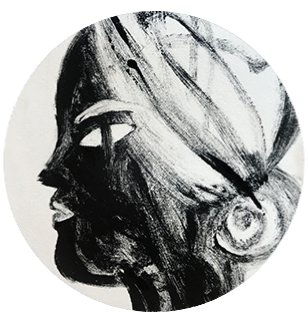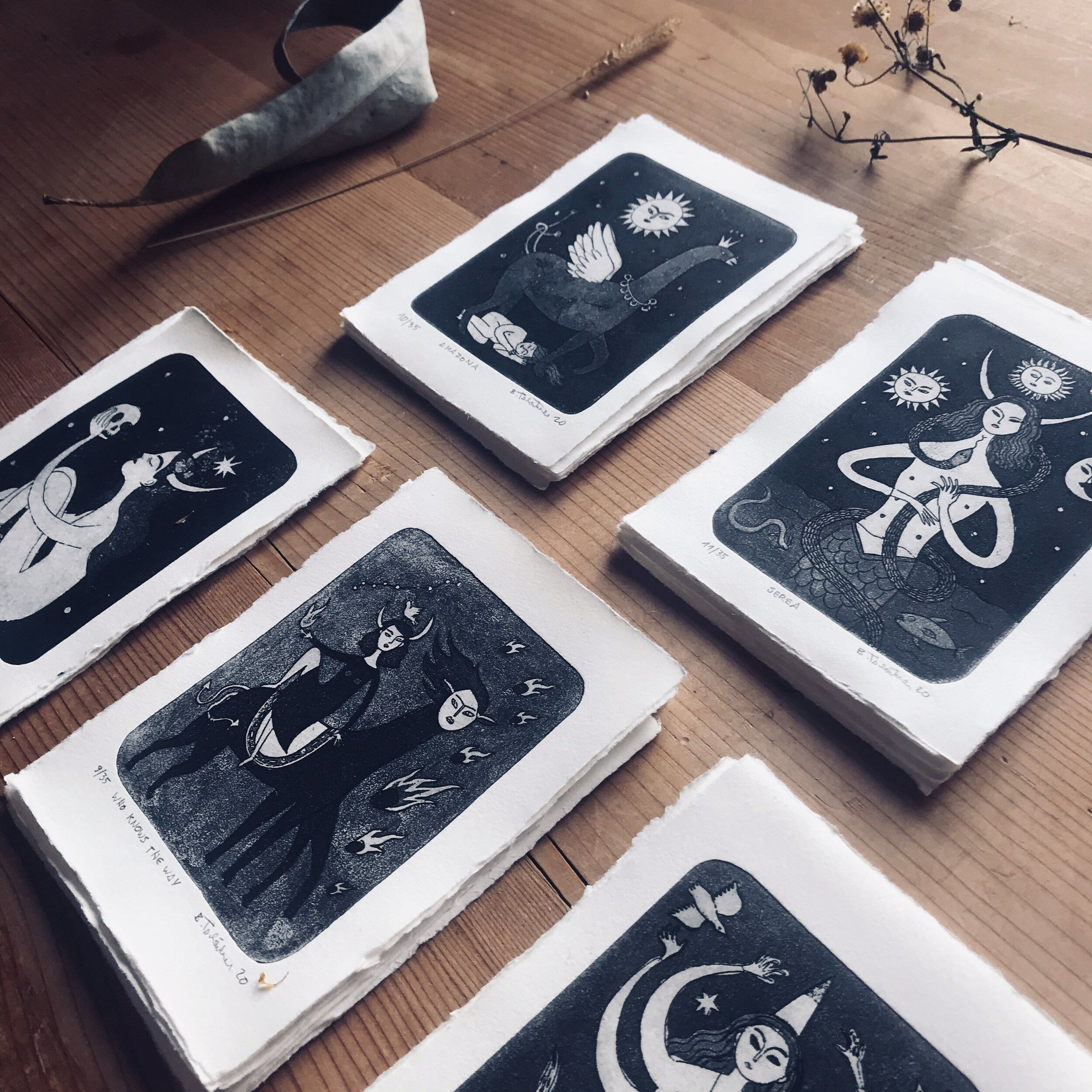The Far Province
May 2021
Galicia is a remote Spanish province – once thought to be the end of the world, it still sometimes feels like the end of the world, a world where one is still at the mercy of nature, her wild waves (it’s no coincidence that the Costa de Morte, the coast of death, is located here) her endless rain and storms and the gigantic piles of cumulus clouds she sends racing across the sky. In times like these, water creeps into your house and makes the windows cry, and with it the cold creeps into your bones and doesn’t leave for weeks and months, and no fire is enough to warm your fingers.
Nature, having invaded your home and your bones, drives you out of your house right into her arms, and you walk along black rivers seamed by shipwrecks and into a forest of dark, wet trees. You pass by houses made of stone that have been abandoned for an eternity, houses in pain, taken over by gravity and ghosts and moss, and on your way back home you pick some pink camellias from the three trees that grow next to the old monastery, that beloved flower only blooming in winter, contradicting the very gloom that brings her to life. Looking up the trees you notice that the blossoms are already yellowing; it is a sign that warmer times are coming soon.
And then, finally, as announced by the dying camellias, spring comes and rewards those who endured winter with fragrant forests, and the dark indigo in the bays turns turquoise, and the clouds become light-weight and white, travelling through the sky like sailing ships.
The strangers on the street are not hiding behind their umbrellas anymore; the sun shining into their faces makes them talkative now, and they start to tell you the secrets of their now blooming country, of what lives in their villages and forests, and in the worlds in between, and they talk about the mystical islands in the South, islands that really exist, although you don’t dare to believe in them.
On days like these, you don’t want to go back home anymore, you almost don’t want to go to the printmaking workshop anymore, where, still, the dark images of winter wait to be brought to light by you.
Those are the days when you don’t want to go home and you almost don’t want to go into the studio anymore, days that almost make you wish you were a flower seller, you want to roam the forests for days, looking for flowers and branches out of which you will make bouquets and wreath which will tell from your walks through the hills, and you want to sell them on the big square, together with the market women, who come down from their gardens on the hills twice a week, carrying baskets full of eggs, home-made cheese and huge loaves of dark bread, and the last lemons of the winter, which are so big that you need two hands to hold them.
For the forest, only the narrow hours between the end of the day and the beginning of the night have been left, you step into a light forest and you leave a dark one.
But you know that the days are getting longer now…
Die Ferne Provinz
Galizien ist eine abgelegene Provinz in Nordspanien – einst glaubte man, hier läge das Ende der Welt, und manchmal fühlt es sich noch immer so an – eine Welt, in der man der Natur völlig ausgeliefert ist, eine Natur, die ruhelos ist und erratisch, die haushohe Wellen gegen die Küste wirft und Wolkenmassen über den Himmel jagt und als nächtelange Stürme rastlos durch Wälder und Dörfer wühlt, begleitet von endlosem Regen. Es ist kein Zufall, dass die Costa da Morte, die Todesküste, hier liegt, in einem Winter wie diesem muss sie ihren Namen wohl bekommen haben.
An Tagen wie diesen dringt das Wasser durch die klammen Mauern in dein Haus und bringt deine Fenster zum Weinen, und mit dem Wasser kriecht die Kälte in deine Knochen und geht nicht mehr weg, für Wochen und Monate, und kein Feuer ist warm genug, um deine Finger zu wärmen.
Dieselbe Natur, die in dein Haus eingedrungen ist, treibt dich jetzt hinaus aus deinem Haus, direkt in ihre Arme. Du gehst an schwarzen Flüsse entlang, die von abgewrackten Booten gesäumt sind, und durch den Wald voller dunkler Bäume, die, obwohl die Wolken schon weitergezogen sind, immer noch voller Regen sind.
Du gehst an Häusern vorbei, in denen längst niemand mehr wohnt, es sind sterbende Häuser, mit herausgebrochenen Fassaden, Häuser, die im Fallen begriffen sind, bewohnt nur noch von Geistern und Moos und dem ewigen Regen.
Auf dem Rückweg pflückst du einen Strauß pinker Kamelien von den drei Kamelienbäumen, die auf der Straße vor dem alten Kloster wachsen. Die Kamelie, diese wundersame Blüte, die nur im Winter blüht, und die in ihrer Üppigkeit und Fleischlichkeit der Schwermut, in der und in der allein sie gedeiht, widerspricht. Dir fällt auf, dass einige der Blütenblätter bereits am Rand vergilben: Ein Zeichen, dass bald wärmere Zeiten kommen.
Und dann, endlich, wie von den sterbenden Kamelien angekündigt, kommt der Frühling und beschenkt diejenigen, die im Winter ausgeharrt haben, mit duftenden Wiesen und Wäldern, plötzlich ist Licht im Meer, die Sonne kommt an Land, und das dunkle Indigo in den Buchten verwandelt sich in helles Türkis, und die Wolken werden leicht und weiß und ziehen durch den Himmel wie Segelschiffe.
Die Fremden auf der Straße verstecken sich jetzt nicht mehr hinter ihren großen Regenschirmen: Die Sonne, die ihnen ins Gesicht scheint, macht sie gesprächig, und sie erzählen dir die Geheimnisse ihres jetzt blühenden Landes, davon, was in ihren Dörfern und Wäldern lebt und in den Welten dazwischen, und sie erzählen dir von den mystischen Inseln im Süden, die wirklich existieren, aber an die zu glauben du kaum wagst.
An Tagen wie diesen willst du nicht mehr nach Hause gehen, und fast willst du nicht mehr in die Druckwerkstatt gehen, wo, immer noch, dunkle Bilder des Winters darauf warten, von dir ans Licht geholt zu werden.
An diesen Tagen wünschst du dir, eine Blumenverkäuferin zu sein, du willst tagelang durch die Wälder streifen, Blumen und Zweige suchen, aus denen du Sträuße und Kränze bindest, die von deinen Spaziergängen durch die Hügel erzählen, und sie auf dem großen Platz zu verkaufen zusammen mit den Marktfrauen, die zweimal in der Woche von ihren Gärten auf den Hügeln herunterkommen, die Körbe voller Eier bringen, selbstgemachten Käse und riesige Laibe dunkles Brot, und die letzten Zitronen des Winters, die so groß sind, dass du sie in beiden Händen halten kannst.
Für den Wald sind dir nur die engen Stunden zwischen Tagesende und Nachtbeginn geblieben, du betrittst einen hellen Wald und verlässt einen dunklen.
Aber du weißt, dass die Tage nun länger werden…




